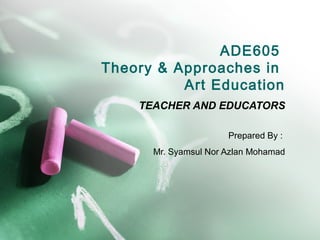
Week 2 Teacher and Educators
- 1. ADE605 Theory & Approaches in Art Education TEACHER AND EDUCATORS Prepared By : Mr. Syamsul Nor Azlan Mohamad
- 2. Definition of Teacher/Educators • A person, who educates, helps others learn, especially in a school or college. • The objective is typically a course of study, lesson plan, or a practical skill, including learning and thinking skills. • The different ways to teach are often referred to as the teacher's pedagogy. • When deciding what teaching method to use, a teacher will need to consider students' background knowledge, environment, and their learning goals as well as standardized curriculum as determined by their school district.
- 3. Teacher Role & Tasks • "The role of the teacher is to enable and guide activities that involve students as thoughtful learners in socially meaningful tasks." (Moll, 1984) • Roles and responsibilities of teacher’s: Keep the students safe Decide what is important for students to learn Protect and improve the students’ self-esteem Provide an environment for the students to explore a variety of experiences Help students use computers and other technology-related tools to accomplish specific tasks Arrange the students’ environment to maximize the probability that they will learn what you want them to learn Make sure students are prepared for the next level of their education Love and nurture the students
- 4. Art Teacher/Educators • All effective teachers have learned to think about teaching in an analytical way. • Teaching comes down to five simple basic components: Why have art in the schools? What should be taught in the art class? How will it be taught? What are the results?
- 5. Why Have Art In The Schools? • Provide teachers with sense of direction. • Express reasons for teaching art with reasonable degree of confidence. • Teachers who lack of a clear understanding of what they are about are like rudderless ships floundering in the seas of education.
- 6. What Should Be Taught In Art? • Elements of design, principles of design, process, procedures and etc. • Art is complex, huge which makes choice about what to teach difficult: Background of the students Amount of the community Size of class Amount and type of materials available. Teachers must remember students learn not only in art classes or under the guidance of teachers.
- 7. How Should Art Be Taught? • Focuses on the way of organizing and structuring instruction and presentation. • Typical school situation (with text book). • Should realize not all students have the same interest, art background and mental ability
- 8. To Whom Art Is Being Taught? • Art is taught to someone and the capabilities and motivation of the students are essential. • Should be aware of probable use the students will make of what they learn. • Try to see the subject through the eyes of the pupils. • This ability is needed not only to know how to adapt materials but to establish a teacher-class relationship that will encourage a positive attitude. • Students often slow to distinguish between feelings towards teachers and feeling towards subject. • Decide on which methods are appropriate for specific material to particular group of students. • Ideas on teaching change – new media and teaching on site.
- 9. What Are The Results? • What do the students know or what are they able to do after the class that they did not know or do before. • Teachers should determine the amount of learning by watching the facial expressions and observable behaviors.
- 10. Planning For Art Teaching • Amount of planning by art teachers. • Aids in planning – materials. • Low-range planning – where does a teacher stat. • Unit planning – specific. • Lesson planning – process of organizing the things a class will do to learn art.
